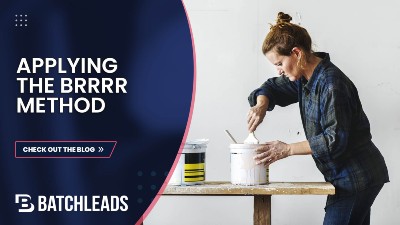The BRRRR method, also known as the “buy, rehab, rent, refinance, repeat” method, is a popular strategy for building wealth through real estate investing. It involves buying a distressed or undervalued property, rehabilitating it to increase its value, renting it out to generate passive income, refinancing it to recoup your initial investment, and then repeating the process with a new property. This method can be a highly effective way to build a profitable real estate portfolio over time.
But if you want to employ this strategy in your real estate business, there are several important details you need to understand about making the most of the process. Otherwise, you could trap yourself with several loans and no good way to pay them off. To help you avoid that unfortunate fate, here’s the ultimate guide to using the BRRRR method to building real estate assets with very little of your own money.
What is the BRRRR method?
Real estate investing has long suffered under a single gatekeeper: the need for existing assets and capital. Simply put, buying investment property is expensive, especially in the early months of 2023. People who don’t already have cash sitting around have traditionally had a hard time investing in real estate.
Thankfully, this has led to the creation of several real estate investment strategies such as wholesaling that don’t require investors to leverage their own money. However, while wholesaling is a great way to get started and build wealth, it won’t leave you with any real estate assets of your own. So if you want to build your own portfolio and develop a sizable passive income stream, you need another strategy.
The BRRRR method is the answer you’re looking for, because it lets you leverage other people’s money to buy and rehab property. Unlike the traditional process of making cash purchases or working with agents to find move-in-ready properties, the BRRRR method is available to almost anyone willing to try it.
How does the BRRRR method work?
In order to use this method to acquire assets, it’s important to understand each letter of the acronym and how to make good decisions in each step.
Buy
The first step is to find a property to purchase. This can be a single-family home, a multi-family unit, or even a commercial property. As long as it’s a discounted property that has the potential to increase in value through rehabilitation, then it’s a viable option.
There are two types of properties that fit this description: distressed properties and homes owned by motivated sellers. Distressed properties are homes that have been damaged and/or neglected, and they’re usually easy to spot. Motivated sellers, on the other hand, are a bit harder to identify. These are homeowners who are facing personal or financial difficulties and need to sell in order to fix them. Their situations can range from pre-foreclosure to declining health, so you usually won’t be able to tell whether or not a home is owned by a motivated seller just by looking at it.
Thankfully, there are reliable ways to find these properties. The best way is to use real estate investing software to aggregate public records, property owner information, and financial insights. With this data, you can easily search your market for motivated sellers and their homes.
Comparatively, you’ll know a distressed property when you see it. It may have roof or structure damage, an overgrown yard, or signs of general neglect. However, records searches aren’t as helpful when looking for these properties. Just because a home is neglected, that doesn’t mean the owner is facing a financial burden. They may not care about the property or they may have just enough money to pay their bills, but not enough to fix property damage.
Because many of these homes won’t show up in a motivated seller search, the best way to find them is by driving for dollars. Driving for dollars is the process of identifying neighborhoods that are likely to have distressed properties and then driving through them to find promising investment opportunities.
Landree Morby’s guide to finding distressed properties by driving for dollars
Once you find a property, there are a few more steps you need to take before you can buy it. First, you need to thoroughly inspect it. Just because a house looks like a good deal, that doesn’t mean it’s not holding some hidden repair needs.
Then, once you understand what will be involved in rehabbing the property, you need two essential pieces of information: its after repair value (ARV) and your maximum purchase price. To get this information, you’ll complete a comparables analysis by looking at the sale prices of similar properties in a two-to-three-mile radius of your deal. If you want to simplify this process, which we highly recommend for the sake of time and accuracy, you can use a comping tool to find comparable houses and calculate your deal’s ARV within seconds.
Once you have all of this information, you’ll be ready to make a purchase. Now you’ll need to work with a money lender to secure a hard money loan that covers the purchase and ideally the rehab costs as well.
Rehab
Once you’ve purchased the property, the next step is to rehab it. This typically involves making repairs or renovations to the property in order to increase its value. These renovations might include things like repairing the roof, updating the kitchen and bathrooms, or adding a fresh coat of paint. The extent of the renovations will depend on the condition of the property and the amount of value you hope to add.
If you have experience working on properties, you can do these steps yourself. However, this can take a lot of time, and if you’re not experienced, you may create financial losses for yourself. For these reasons, many investors choose to hire contractors.
Rent
After you’ve rehabbed the property, the next step is to rent it. Because you’ve recently renovated a property that you bought for below-market value, your rental revenue should cover the costs of owning the property and generate passive rental income for you as well.
As a landlord, it will be your responsibility to find tenants, collect rent, and handle any maintenance or repair issues that arise. However, if you don’t want to handle these responsibilities and you’re willing to share your profits, you can hire a property manager. This individual or company will find renters, manage them, and deal with any issues that arise.
Refinance
Once you’ve owned and rented the property for an appropriate seasoning period, which is typically at least six months, you can refinance it. Refinancing usually gives a property owner their initial investment back, but because you’ve rehabbed the property, you’ve raised its value.
The refinancing institution will appraise the property, see that it’s been recently rehabilitated, and then lend you approximately 70-80% of the appraised value. This is known as a cash-out refinance, and when you’re using the BRRRR strategy, it’s a great way to finance your next purchase.
Repeat
Once you’ve recouped your initial investment, and hopefully received a bit extra with the new appraisal, you can repeat the process with a new property. By buying, rehabbing, renting, and refinancing multiple properties over time, you can build a sizable real estate portfolio that generates passive income for you.
Pros and cons of using the BRRRR method
The main benefit of the BRRRR method is that it allows you to acquire real estate without much capital. As long as you can secure an initial mortgage on your first property, you can create a chain effect that lets you build a rental portfolio.
Another key benefit is that it allows you to leverage your initial investment in order to acquire additional properties. By using the equity in one property to purchase another, you can effectively multiply your investment and build wealth more quickly. This can be especially appealing for investors who are just starting out and may not have a large amount of capital to work with.
An additional advantage of the BRRRR method is that it can provide assets that pay for themselves. Because you buy properties at a discount, then rehab and rent them, your rental revenue should more than cover your monthly loan payments, meaning it’s also a great way to establish a passive income stream. This can be especially appealing for investors who are looking for a way to generate income without having to work full time.
There are, however, some risks and challenges associated with the BRRRR method. One of the biggest risks is the possibility of unexpected repair or maintenance costs. Rehabbing a property can be a complex and costly process, and there is almost always risk of unexpected issues eating into your profits. It’s important to carefully assess the condition of a property before you buy it and to set aside a budget for unexpected repairs.
Another risk is the possibility of vacancy. Even if you have a strong rental market, it’s always possible that your property will be vacant for a period of time. If this happens, you may find yourself stuck paying for a property that you didn’t budget for, making it more difficult to cover your costs. To avoid this scenario, you’ll need a solid marketing and tenant acquisition strategy.
Finally, there’s the risk of changes in the real estate market. While the BRRRR method can be highly profitable in a rising market, it can be more challenging in a stagnant or declining one. As we’ve seen in 2022, interest rate changes can also impact how you leverage this method. If interest rates increase before you can refinance, you may be stuck paying more for a property on the back end. These factors mean that it’s always important to carefully assess the state of local real estate and to be prepared for potential changes before you make any purchases.
Conclusion
Despite these risks, the BRRRR method can be a highly effective way to create wealth by building a portfolio of rental properties, especially if you don’t have much cash on hand. While traditional real estate investors rely on leveraging their own money to build a rental portfolio, you can leverage debt to build a sizable portfolio in just a few years.
Of course, this strategy won’t create a flood of cash in the short term. However, it will raise your net worth and give you a handful of assets that you can use to create other opportunities in the future. Once your loans are paid off, you’ll enjoy a steady income stream.
The best part is that you don’t have to use this strategy exclusively. If you want to wholesale as well and land large assignment fees from a single deal, that option is always available. In real estate, you’re only limited by what you’re willing to achieve, and the BRRRR method is one of the greatest ways to get started.
Want to learn more about the ins and outs of the BRRRR method?

Download our free E-book on Decoding Real Estate Investing: Knowledge + Advice from Industry Leaders. Inside, you’ll find a full interview with professional investor David Dodge explaining how he uses the BRRRR method to drive his business!



